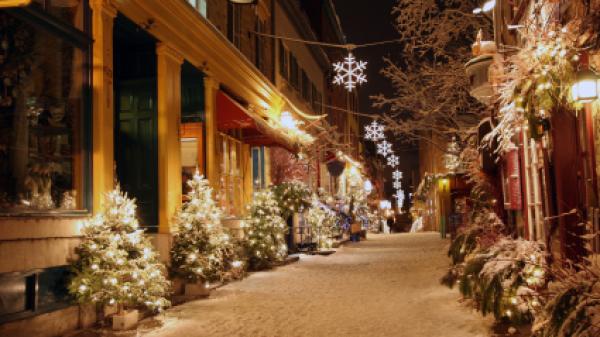Holidays and Traditions around the December solstice
The December solstice is the Winter Solstice in the Northern Hemisphere and the Summer Solstice in the Southern Hemisphere. The day has astronomical, cultural, and religious significance.

Dusk in Lapland around the time of the winter solstice in December.
©bigstockphoto.com/zlikovec
In the Northern Hemisphere, the December solstice is the winter solstice and the shortest day of the year.
Although winter is the season of dormancy, darkness and cold, the December solstice marks the "turning of the Sun" and the days slowly get longer. Celebrations of the lighter days to come and nature’s continuing cycle have been common throughout cultures and history with feasts, festivals and holidays around the December solstice.
Christmas Celebrations
In modern times Christians all over the world celebrate the birth of Jesus Christ on Christmas Day, which falls on December 25.
However, it's believed that this date was chosen to offset pagan celebrations of Saturnalia and Natalis Invicti. Some believe that celebrating the birth of the “true light of the world” was set in synchronization with the December solstice because from that point onwards; the days began to have more daylight in the Northern Hemisphere.
Seven weird and wonderful Christmas traditions
Christmas is also referred to as Yule, which is derived from the Norse word jól, referring to the pre-Christian winter solstice festival.
Yule is also known as Alban Arthan and was one of the “Lesser Sabbats” of the Wiccan year in a time when ancient believers celebrated the rebirth of the Sun God and days with more light. This took place annually around the time of the December solstice and lasted for 12 days. The Lesser Sabbats fall on the solstices and equinoxes.

Christmas decorations include lights and stars.
©iStockphoto.com/Alexander Kolomietz
Feast of Juul
The Feast of Juul was a pre-Christian festival observed in Scandinavia at the time of the December solstice. Fires were lit to symbolize the heat, light and life-giving properties of the returning sun. A Yule or Juul log was brought in and burned on the hearth in honor of the Scandinavian god Thor.
A piece of the log was kept as both a token of good luck and as kindling for the following year’s log. In England, Germany, France, and other European countries, the Yule log was burned until nothing, but ash remained. The ashes were then collected and either strewn on the fields as fertilizer every night until Twelfth Night or kept as a charm and or as medicine.
French peasants believed that if the ashes were kept under the bed, they would protect the house against thunder and lightning. The present-day custom of lighting a Yule log at Christmas is believed to have originated in the bonfires associated with the feast of Juul.
Saturnalia in Ancient Rome
In Ancient Rome the Winter Solstice festival Saturnalia began on December 17 and lasted for seven days.
Saturnalian banquets were held from as far back as around 217 BCE. The festival was held to honor Saturn, the father of the gods and was characterized by the suspension of discipline and reversal of the usual order. Grudges and quarrels were forgotten while businesses, courts, and schools were closed. Wars were interrupted or postponed, and slaves were served by their masters. Masquerades often occurred during this time.

The ruins of the Temple of Saturn in Rome's Forum Romanum, Italy.
©bigstockphoto.com/josefkubes
It was traditional to offer gifts of imitation fruit (a symbol of fertility), dolls (symbolic of the custom of human sacrifice), and candles (reminiscent of the bonfires traditionally associated with pagan solstice celebrations). A mock king was chosen, usually from a group of slaves or criminals, and although he was permitted to behave in an unrestrained manner for seven days of the festival, he was usually killed at the end. The Saturnalia eventually degenerated into a week-long spree of debauchery and crime – giving rise to the modern use of the tern saturnalia, meaning a period of unrestrained license and revelry.
Modern Day Celebrations
In Poland, the ancient December solstice observance before Christianity involved people showing forgiveness and sharing food. It was a tradition that can still be seen in what is known as Gody.
In the northwestern corner of Pakistan, a festival called Chaomos takes place among the Kalasha or Kalash Kafir people. It lasts for at least seven days, including the day of the December solstice. It involves ritual baths as part of a purification process, as well as singing and chanting, a torchlight procession, dancing, bonfires, and festive eating.

Celebrating Santo Tomas in Chichicastenango, Guatemala, December 21, 2008.
Santo Tomas in Guatemala
Many Christians celebrate St Thomas’ Day in honor of St Thomas the Apostle on December 21. In Guatemala on this day, Mayas honor the sun god they worshipped long before they became Christians with a dangerous ritual known as the Palo Volador, or “flying pole dance”. Three men climb on top of a 50-foot pole. As one of them beats a drum and plays the flute, the other two men wind a rope attached to the pole around one foot and jump. If they land on their feet, it is believed that the sun god will be pleased and that the days will start getting longer. Some churches celebrate St Thomas’ Day on other days in the year.
The ancient Incas celebrated a special festival to honor the sun god Inti at the time of the December solstice. In the 16th century, ceremonies were banned by the Roman Catholics in their bid to convert the Inca people to Christianity. A local group of Quecia Indians in Cusco, Peru, revived the festival in the 1950s. It is now a major festival that begins in Cusco and proceeds to an ancient amphitheater a few miles away.